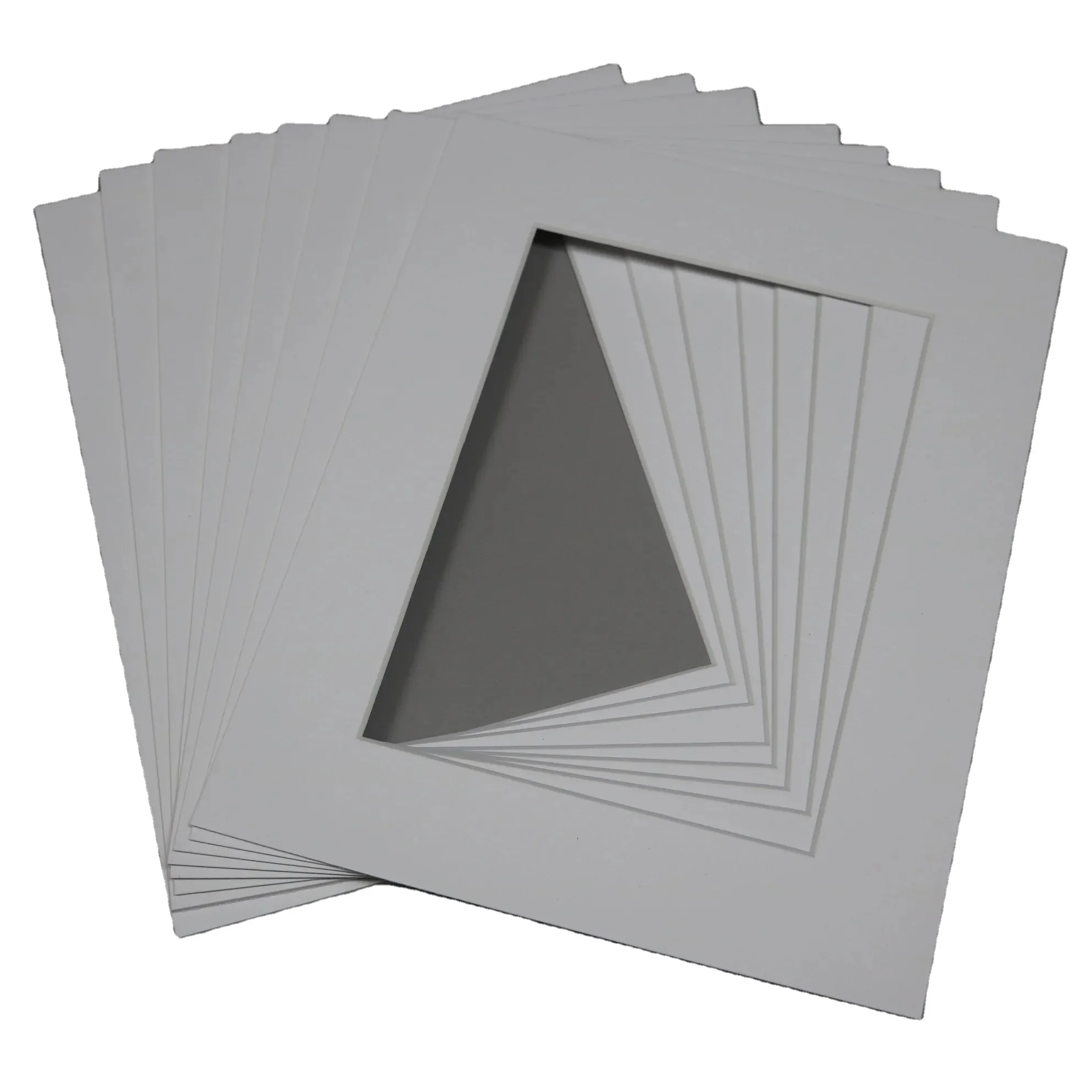Професионалното представяне на художествени произведения изисква внимателно отношение към всеки детайл, а паспарту дъските служат като основа за създаване на визуално впечатляващи експозиции, които предпазват и подчертават вашите творби. Тези задължителни компоненти за рамкиране осигуряват идеална рамка между творбата и рамката, създавайки дълбочина, фокус и професионален вид, които превръщат обикновените произведения в експонати, достойни за галерия. Независимо дали сте професионален рамкиращ специалист, художник или ценител на изкуството, разбирането на влиянието на качествените паспарту дъски върху вашата експозиция може да промени начина, по който се възприема и запазва вашето изкуство.

Разбиране на основите на паспарту дъските
Основен състав и материали
Материалите за рамки се състоят от множество слоеве внимателно проектирани материали, предназначени да осигурят структурна подкрепа, като същевременно запазват архивно качествени стандарти. Основата обикновено е от плътна маса от дървесна пулпа, заобиколена от покривни хартии, които определят окончателния външен вид и текстура. Висококачествените материали за рамки използват напълно киселинно-неутрални материали в цялата си конструкция, предотвратявайки химически реакции, които биха могли да повредят произведенията на изкуството при продължително съхранение. Тази композиция гарантира, че вашето инвестиране в качествени материали за рамки ще защитава ценни творби в продължение на десетилетия.
Производственият процес включва прецизни техники за ламиниране, които свързват тези слоеве, без да компрометират структурната цялост. Съвременните производствени методи използват напреднали адхезиви, които остават стабилни при различни температурни и влажностни условия, като по този начин продуктите стават подходящи за разнообразни среди за показване. Разбирането на тези основни характеристики помага на рамкаджии и художници да вземат обосновани решения относно това кои материали най-добре отговарят на конкретните им изисквания за представяне.
Вариации в дебелината и приложения
Стандартните матови дъски се предлагат в различни дебелини, обикновено в диапазона от 4-слоен до 8-слоен вариант, като всеки служи за различни цели при представянето. Опцията с дебелина 4-слоен осигурява достатъчна подкрепа за леки елементи и създава незабележима дълбочина, без да претоварва по-малки произведения на изкуството. В същото време вариантите с дебелина 8-слоен предлагат драматичен ефект на сянка и значително присъствие, което допълва по-големи и по-масивни елементи, изискващи смели решения в представянето.
Профессионалните рамки обикновено комбинират различни дебелини в една и съща презентация, за да създадат наслоени ефекти, които добавят визуален интерес и пространствена сложност. Тази техника позволява креативни изрази, които надхвърлят простото създаване на рамки и превръщат фона в цялостен дизайнерски елемент, който подсилва общото художествено въздействие. Изборът между опциите за дебелина зависи от размера и теглото на произведението, естетическите предпочитания и желаното визуално послание.
Избор на цвят и ефект върху дизайна
Традиционни цветови схеми
Класическите бяла и пастелнобяла рамки продължават да бъдат най-популярните избори поради своята универсалност и способност да подхождат на почти всяко произведение на изкуството, без да привличат визуалното внимание. Тези неутрални тонове създават чист и професионален вид, който позволява на художественото произведение да бъде в центъра на вниманието, като осигурява необходимото визуално разделяне от рамката. Представянията с музейно качество често разчитат на тези проверени от времето опции, защото запазват своя външен вид в продължение на дълги периоди, без да показват следи от износване или оцветяване.
Кремавите и естествени тонове предлагат деликатно топлина, която работи особено добре с традиционни художествени произведения, винтажни елементи и топли цветови палитри. Тези опции предлагат изискани алтернативи на чисто бялото, като запазват професионалния вид, който изискват колекционерите и галериите. Леката тонова вариация може да подсили определени художествени стилове, без да създава отвличащи контрасти, които биха могли да намалят общото качество на представянето.
Смелите и креативни цветови опции
Съвременните рамки за матове са налични в обширни цветови гами, които позволяват креативно изразяване и стратегически дизайнерски решения, допълващи определени художествени теми. Тъмносините, наситените бордо и горските зелени цветове могат да създадат драматични контрасти, които подчертават произведението на изкуството, като същевременно запазват изискан външен вид. Тези смели избори работят особено добре с черно-бяла фотография, монохромно изкуство и творби, които печелят от силни цветови взаимоотношения.
Специални повърхности, включително текстурирани, с метални акценти и покрити с плат, предлагат допълнителни креативни възможности за уникална презентация. Тези премиум материали позволяват на рамарите да създават персонализирани външни видове, отразяващи характера на художественото произведение и личните предпочитания на собственика. При избора на ярки цветове имайте предвид околната среда за вгледване и се уверете, че избраните тонове ще останат подходящи при различни условия на осветление и интериорни настройки.
Технически спецификации и стандарти за качество
Изисквания за безкислотни материали
Без киселини рамки представляват златния стандарт за архивни рамки, където дългосрочното запазване е от съществено значение. Тези материали преминават през специални производствени процеси, които елиминират киселинните съединения, отговорни за пожълтяване, крехкост и химическо повреждане, които с времето могат да се предадат на произведението на изкуството. Професионалните консерватори и музеите използват изключително безкиселинни материали, за да гарантират, че ценни творби ще останат в безупречно състояние за бъдещите поколения.
PH нивата в качествените матови дъски обикновено варират между 7,5 и 9,5, създавайки алкална среда, която активно неутрализира околната среда от киселини и замърсители. Тази химическа стабилност предотвратява разграждането, което засяга стандартните материали на база дървесна пулпа, което прави безкиселинните опции задължителни за всяко произведение на изкуството с голяма парична или емоционална стойност. Допълнителната цена на висококачествените материали представлява разумен инвестиционен ход за дългосрочно запазване и защита.
Димензионална стабилност и продължителност
Матовите дъски от професионално ниво запазват формата и размерите си при различни условия на околната среда, предотвратявайки деформация, огъване или разширяване, които биха могли да повредят рамкирано изкуство. Тази стабилност се постига чрез прецизно контролирано съдържание на влага по време на производството и използването на висококачествени ядрени материали, устойчиви към промени в околната среда. Постоянството в размерите гарантира, че точните резове остават коректни с течение на времето, осигурявайки чисти линии и професионален вид.
Изпитванията за издръжливост на матовите дъски високо качество включват излагане на ускорени условия на стареене, промени в температурата и вариации на влажността, които имитират десетилетия нормална употреба. ПРОДУКТИ тези, които отговарят на строгите стандарти, демонстрират своята пригодност за стойностни творби и изискващи среди за изложба. Тази надеждност прави качествените матови дъски задължителен компонент в професионални рамкиране операции, където репутацията зависи от дълготрайни резултати.
Техники за рязане и прецизност
Професионални методи за рязане
Прецизното рязане представлява един от най-важните аспекти при професионалната подготовка на рамки за картини, като изисква специализирани инструменти и техники, които гарантират чисти и точни фасовани ръбове. Професионалните рязални устройства използват остри, сменяеми лезвия, които осигуряват гладко рязане без разкъсване или изтриване на лицевата хартия. Ъгълът на фаската, обикновено 45 градуса, създава характерната сянка, която придава дълбочина и професионален вид на крайния продукт.
Напреднали системи за рязане включват измервателни шини, ограничители и позиционни помагала, които осигуряват последователни резултати при обработка на множество парчета. Тези инструменти позволяват на рамите да постигат прецизни измервания и идеални ъглови съединения, които демонстрират професионално майсторство. Правилното поддържане на ножовете и техниката на рязане директно повлиява върху крайното качество на представяне, което прави инвестициите в качествени инструменти и обучение задължителни за професионални резултати.
Персонализирани конфигурации на отвори
Освен стандартните правоъгълни отвори, съвременните възможности за рязане на рамки включват овални, кръгли и персонализирани форми, които отговарят на уникални изисквания за артистични произведения. Конфигурациите с множество отвори позволяват групирането на свързани елементи в една рамка, създавайки цялостни презентации, които разказват визуални истории или ефективно показват колекции. Тези напреднали техники изискват специализирани инструменти и експертност, но предлагат неограничени творчески възможности.
Цифровите системи за рязане осигуряват точно възпроизвеждане на сложни форми и шаблони, което позволява на рамарите да създават изящни дизайни, невъзможни чрез традиционни ръчни методи за рязане. Тези технологични постижения разширяват творческите възможности, като запазват прецизността и качеството, изисквани за професионални презентации. Персонализираните конфигурации могат да превърнат прости проектите за рамкиране в отличителни художествени изрази, отразяващи както произведението, така и уменията на рамаря.
Ползи при консервацията и запазването
Функции на защитна бариера
Матовите дъски служат като важни защитни бариери, които предотвратяват директния контакт на картини с материали за окачествяване, елиминирайки риска от залепване, увреждане от влага и повърхностни драскотини, които могат завинаги да повредят ценни експонати. Това разделяне създава необходимото междинно пространство за въздух, което позволява свободно разширяване и свиване при промени на температурата, като едновременно предотвратява кондензацията, която може да причини водни увреждания или образуване на плесен. Защитната функция става особено важна при променящи се климатични условия, където често се появяват колебания в температурата и влажността.
Качествените подложки за рамки също осигуряват буфер срещу замърсители от околната среда, прах и въздушни замърсители, които постепенно се натрупват около произведенията на изкуството с течение на времето. Алкалните свойства на киселинно-нейтралните материали активно неутрализират кисели съединения, които в противен случай биха могли да причинят химическо повреди на чувствителни медии като акварели, пастели и фотографски отпечатъци. Тази защитна функция значително удължава живота на произведенията на изкуството в сравнение с директните методи за монтиране.
Стратегии за дългосрочно запазване
Профессионалното консервационно рамкиране включва множество слоеве подложки за създаване на подобрени защитни системи, които отговарят на различните изисквания за запазване. Техниките за двойно матиране използват консервационни подложки в комбинация с декоративни лицеви матове, осигурявайки както естетическа привлекателност, така и максимална защита. Този подход позволява повторно рамкиране в бъдеще, без да се размества произведението на изкуството, като по този начин се поддържат архивни стандарти през целия процес на запазване.
Инсталациите от музеен клас често включват системи за разстояване и специализирани методи за монтиране, които работят заедно с висококачествени рамки за картини, за да създадат оптимална среда за запазване. Тези всеобхватни подходи гарантират, че ценни произведения на изкуството ще останат в първоначално състояние в продължение на дълги периоди, като така се защитават инвестиции и културно наследство за бъдещо оценяване. Комбинацията от подходящи материали и професионални техники представлява най-високия стандарт в запазването на художествени творби.
ЧЗВ
Каква дебелина на рамката за картина трябва да избера за моето произведение на изкуството
Подходящата дебелина на картонената рамка зависи от размера на картината, стила на рамката и желания визуален ефект. За стандартни размери от 8x10 до 16x20 инча, матовите плочи с дебелина 4-слоя осигуряват достатъчна подкрепа и професионален вид. По-големите творби или експонати, изискващи драматична представяне, се отразяват добре от опциите 6-слоя или 8-слоя, които създават по-значителни сенчести ефекти и по-силно визуално присъствие. Имайте предвид дълбочината на рамката и общите цели за представяне при избора на дебелина.
Как да определя правилната ширина на матовия ръб за моята творба
Традиционните насоки за матиране препоръчват ширини на ръбовете между 2,5 и 4 инча за повечето творби, като по-големите експонати могат ефективно да се комбинират с по-широки ръбове. Долният ръб често се изрязва малко по-широк от горния и страничните, за да се постигне визуален баланс и да се предотврати усещането картината да потъва в рамката. Имайте предвид пропорциите на творбата, разстоянието за разглеждане и околната среда при излагане, когато определяте оптималните размери на ръбовете за най-благоприятен визуален резултат.
Мога ли да използвам обикновени подложки за ценни художествени произведения
Ценните художествени произведения изискват неутрални по рН, консервационни подложки, за да се предотврати дългосрочното увреждане вследствие на химични реакции и външни фактори. Обикновените подложки съдържат киселини, които с течение на времето пожълтяват и могат да прехвърлят вредни съединения върху творбата, причинявайки постоянни петна и разрушаване. Допълнителната инвестиция в архивни материали пази стойността на вашето произведение и осигурява запазването му за бъдещи поколения, което прави неутралните по рН подложки задължителни за всяко произведение с голяма стойност.
Какво обслужване изискват рамкираните експонати с подложки
Правилно рамкираните произведения с качествени матови дъски изискват минимално поддържане, освен редовно премахване на праха от рамката и повърхностите на стъклото. Избягвайте използването на почистващи продукти директно върху рамката и се уверете, че средата за показване поддържа стабилни температура и ниво на влажност. Проверявайте периодично произведенията за признаци на дейност на насекоми, увреждане от влага или промяна в цвета на матовата дъска, които може да сочат на проблеми в околната среда, изискващи професионално внимание, за да се предотвреди увреждане на произведението.

